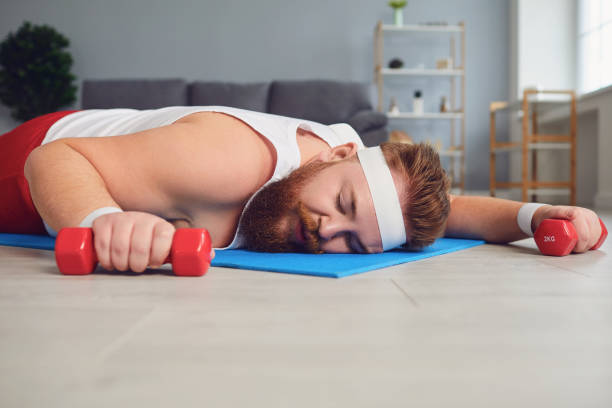
The counterintuitive truth about what’s really sabotaging your fitness goals
Meet John. He hits the gym with the dedication of a monk, eats more vegetables than a health food store clerk, and somehow still looks like he’s been photoshopped with the “before” filter permanently enabled. Sound familiar?
John represents millions of men over 30 caught in what I call the “effort illusion”—working hard but working wrong. His story isn’t unique, but his wake-up call might surprise you.
The Brutal Truth About Post-30 Physiology
Here’s what John didn’t know: his body stopped playing by the same rules sometime after 30. Like a smartphone that mysteriously runs slower after every update, his metabolism had quietly shifted into “energy conservation mode.”
The Training Reality Check
John could hold full conversations during his weightlifting sessions. This felt “sustainable” and “smart”—like he’d discovered the secret sauce of mature fitness. In reality, he was training at roughly 40-60% intensity—the equivalent of trying to break down a door by politely knocking on it.
Translation: His muscles weren’t getting the signal to grow—they were getting the signal to file paperwork and call it a day.
The Nutrition Blind Spot
His “healthy” low-fat, vegetable-heavy diet was actually working against him like a well-intentioned but misguided personal assistant:
- Protein intake likely under 0.8g/kg when he needed 1.6-2.0g/kg for muscle maintenance (Moore et al., 2015, Applied Physiology, Nutrition, and Metabolism)
- Insufficient dietary fat for testosterone production
- Blood sugar chaos leading to evening sugar binges
The Recovery Trap
Joint pain, back discomfort, and post-workout fatigue weren’t signs he was “working hard”—they were his body’s way of filing a formal complaint with HR.
The Post-30 Muscle Code: What Actually Works
The solution isn’t about doing more. It’s about doing differently—like finally reading the manual instead of assuming you can figure out IKEA furniture by staring at it harder.
1. Training That Actually Triggers Change
- Implement RPE 7-8 intensity (conversation should be difficult, not impossible)
- Focus on compound movements with proper periodization
- Use tempo work (3-1-3 cadence) to increase time under tension without crushing joints
- Progressive overload through multiple variables, not just weight
- Incorporate movement “snacks” throughout the day
2. Strategic Nutrition for Muscle Maintenance
Protein Prioritization:
- 1.6-2.0g/kg body weight daily (120-150g for most men)
- 30-40g per meal, distributed evenly
- Leucine-rich sources post-training (whey, eggs, grass-fed beef)
Carbohydrate Timing:
- Higher intake around training sessions
- Front-load earlier in the day
- Eliminate simple sugars after 7pm
Fat Reintroduction:
- 30-35% of calories from healthy fats
- Include testosterone-supporting sources (egg yolks, olive oil)
- Omega-3 rich fish 2-3x weekly
3. Recovery That Actually Recovers
Sleep Optimization:
- Consistent sleep/wake schedule
- No alcohol within 3 hours of bedtime
- Stop eating 3 hours before sleep
Joint Support Protocol:
- Collagen supplementation (15-20g daily) with vitamin C pre-workout
- Omega-3 supplementation (2-3g EPA/DHA daily)
- Proper movement assessment and correction
4. Hormone Optimization (The Natural Way)
- Vitamin D levels at 50-60 ng/ml
- Zinc supplementation (25-30mg daily)
- Magnesium (400-500mg daily)
- Time-restricted feeding (8-10 hour window)
The Implementation Reality
Transformation doesn’t happen overnight, and complete overhauls usually fail. Here’s the phased approach that works:
Weeks 1-2: Protein increase, sleep hygiene, basic supplementation Weeks 3-4: Time-restricted eating, workout intensity increase Weeks 5-8: Full protocol implementation
Expected Timeline:
- Energy improvements: 2-3 weeks
- Joint pain reduction: 3-4 weeks
- Visible changes: 6-8 weeks
- Significant transformation: 12-16 weeks
The Mindset Shift That Changes Everything
At 30+, your margin for error is smaller, but your potential for transformation remains remarkably high. The key is understanding that “healthy” and “effective” aren’t always the same thing—like how “fat-free” and “tastes like cardboard” often go hand in hand.
John’s story isn’t about age being a limitation—it’s about precision becoming essential.
The men who transform after 30 aren’t the ones who work hardest. They’re the ones who work smartest. Think less “beast mode,” more “chess master.”
What’s your biggest challenge with post-30 fitness? The cookie-cutter advice that worked in your twenties, or finding what actually works now?
References:
Burd, N. A., et al. (2019). Muscle protein synthesis rates after resistance exercise in younger and older men. Journal of Applied Physiology, 127(3), 569-576.
Moore, D. R., et al. (2015). Protein requirements for masters athletes: just older versions of their younger selves. Applied Physiology, Nutrition, and Metabolism, 40(9), 902-911.
Phillips, S. M., & Van Loon, L. J. (2011). Dietary protein for athletes: from requirements to optimum adaptation. Journal of Sports Sciences, 29(S1), S29-S38.
Trommelen, J., & Van Loon, L. J. (2016). Pre-sleep protein ingestion to improve the skeletal muscle adaptive response to exercise training. Nutrients, 8(12), 763.